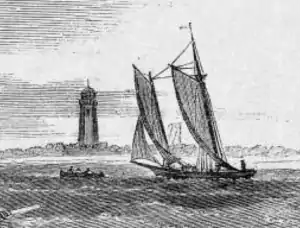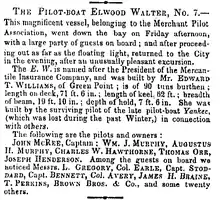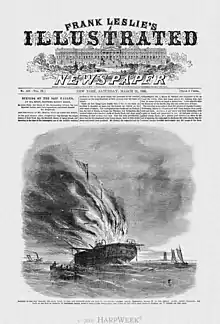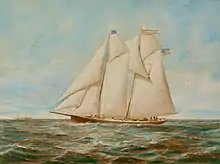Ellwood Walter, No. 7
The Ellwood Walter, No. 7 (1853) was a pilot boat used by the New York Sandy Hook Pilots in the 19th century. The schooner was used to pilot vessels to and from the Port of New York and New Jersey. In the book, From Sandy Hook to 62°, Charles Edward Russell, said: "In 1860 there were twenty-one New York pilot boats." The Elwood Walter, No. 7 was listed as one of these early American pilot boats. [1][2]
 | |
| History | |
|---|---|
| Name: | Ellwood Walter, No. 7 |
| Namesake: | E. W. |
| Owner: | Joseph Henderson, William J. Murphy, Augustus H. Murphy, Charles W. Hawthorne, Thomas Orr |
| Operator: | Joseph Henderson |
| Route: | New York Harbor |
| Builder: | Edward F. Williams |
| Launched: | 1853 |
| Acquired: | about 1853 |
| In service: | about 1853 |
| Out of service: | after 1863 |
| General characteristics | |
| Tonnage: | 90 tons |
| Length: | 71' 6" |
| Beam: | 19' 10" |
| Draught: | depth of hold 7' 6" |
| Propulsion: | schooner sail |
| Sail plan: | Schooner-rigged |
| Speed: | 10 knots |
| Complement: | not known |
Construction and service
In January 1853, the Ellwood Walter was built by Edward F. Williams of Greenpoint, Brooklyn, New York. The schooner was named after Ellwood Walter, the President of the Mercantile Mutual Insurance Company. Walter had extensive experience and knowledge as an insurance underwriter.[3][4]
The Ellwood Walter was 90 tons in weight, 71' 6" length on deck, 2' length of keel, 19' 10" breadth of beam, and 7' 6" depth of hold. It was owned by the following pilots: Joseph Henderson, William J. Murphy, Augustus H. Murphy, Charles W. Hawthorne, and Thomas Orr.[5]
Several Sandy Hook pilots received their pilot license sailing on the Elwood Walter. Captain Joseph Henderson received his license as a Branch Pilot on the Elwood Walter on September 13, 1853, from the Board of Commissioners of Pilots. He was a commander of the Elwood Walter throughout his training.[6]
Operational history
Several important events about the Ellwood Walter, No. 7 pilot boat were reported in many of the New York newspapers and journals. Note, sometimes Ellwood Walter is spelled as "Elwood Walter".
Excursion down the bay

On May 16, 1853, a feature article appeared in the New York Morning Courier reporting that: "The Pilot-Boat Elwood Walter, No. 7, belonging to the Merchants' Pilot Associations, went down the bay on Friday afternoon, with a large party of guests on board, and after proceeding out as far as the floating light, returned to the city in the evening, after an unusually pleasant excursion." The article also talks about the construction and service of the Elwood Walter and who were the pilots and owners. It used an abbreviation for the boat as the "E.W.".[7]
Bad weather conditions
Bad weather conditions plagued the pilot boats in the winter. On January 14, 1856, The New York Herald announced that due to recent severe winter weather, pilot boats and their pilots were suffering. The Elwood Walter, No. 7 was among the pilot boats that arrived safely from outside the New York Harbor.[8]
On January 21, 1857, the Elwood Walter, No. 7 was reported "AT STATEN ISLAND IN THE ICE." The report describes the bad weather conditions a day after a major storm. It lists the owners of the Elwood Walter, and says "this boat is also hard and fast at Staten Island."
Boarding vessels at sea

Pilots boarding ships at sea to help them navigate coming into the New York harbor was the main business of the Sandy Hook pilots. On August 3, 1855, the New York Times Memorandum reported that from the pilot boat Elwood Walter, No. 7, a pilot boarded the ship J. Jones, from Cardiff, Wales and was headed for New York.[9]
On May 20, 1858, the ship Samaritan was boarded by a pilot from Pilot Boat Elwood Walter, No. 7. The Samaritan had sailed 31 days from Liverpool before reaching the New York harbor.
On March 15, 1860, the Elwood Walter, No. 7, helped take the officers and crew off the ship Wabamo, in the New York harbor, when it caught fire while going down the bay outside Sandy Hook. The New York Daily Tribune ran a story that read: "BURNING OF THE SHIP WABAMO IN NEW YORK HARBOR – In New York, this day, the ship Wabamo, Captain Doty bound from New York for Antwerp caught fire about noon, while going down the bay, and burned to the water's edge. The flumes spread with such rapidity as to defy every effort to subdue them. The officers and crew were taken off by the pilot boat Elwood Walter, saving little more than the clothing on their backs. The ship was owned by Messrs. Hurlbut Latin & Co., and was valued at $32,000. Her loss is covered by insurance. She had an assorted cargo of merchandise valued at $70,000 which was insured for $54,457."[10] [11] [12]
On October, 10, 1860, New York Sandy Hook Pilot Augustus H. Murphy, of the pilot boat Ellwood Walter, No. 7, signed a statement along with other pilots, that they were satisfied with the representation they have received from the New York Board of Commissioners of Pilots.[13] Other reports of the Ellwood Walter were reported from 1861 to 1863 by the New York Times.
Edmund Driggs

New York pilot-boat Edmund Driggs, No. 7, was launched from the shipyard of E. F. Williams, at Greenpoint, Brooklyn on 27 February 1864. She was 70 feet long, 18 1/2 feet in beam, 7 feet depth of hold, and 90-tons burthen. She was the replacement for the Elwood Walter No. 7.[14]
The Edmund Driggs, was named for Edmund Smith Driggs (1809-1889) an old Williamsburg, Brooklyn resident and president of the village of Williamsburg in 1850.[15]
She took her first trial trip on 5 March 1864 with Captain Augustus H. Van Pelt down the New York harbor to the Sandy Hook Lightship and back. There were a large number of guests and pilots on board. She was piloted by Richard Bowen, James H. Tenure, Jacob Vanderbilt, Edward Hilliker, John W. Mrray, and Captain Augustus H. Van Pelt.[16]
The Edmund Driggs, No. 7, was cast ashore in the Great Blizzard of 1888 but survived the storm with no casualties.[17] On 27 July 1894, a pilot on the Edmund Driggs, No. 7, boarded the French man-of-war Huzzard outside the Sandy Hook bar.[18]
On 1 February 1896, the New York Pilots discarded sixteen sailboats and moved them to the Erie Basin in Brooklyn. They were replaced with steam pilot boats. The Edmund Driggs, was sold for $3,500.[19]
References
- Russell, Charles Edward (1929). "From Sandy Hook to 62°". www.Worldcat.org. Century Co., New York. Retrieved January 20, 2020.
- Russell, Charles Edward (1929). "From Sandy Hook to 62°: Being Some Account of the Adventures, Exploits and Services of the Old New York Pilot-Boat". www.Google.com. Retrieved January 20, 2020.
In 1860 there were twenty-one New York pilot-boats and four under the New Jersey dispensation. No. 7, Elwood Walter.
-
"Our Shipyards, Jabez Williams". fultonhistory.com. The New York Times. May 16, 1853. Retrieved January 22, 2020.
From the same yard, by Mr. Edward F. Williams, the pilot-boat Elwood Walter, 90 tons, page 3.
-
Silka, Henry. "Shipbuilding and the Nascent Community of Greenpoint, New York, 1850–1855" (PDF). www.cnrs-scrn.org. Retrieved January 20, 2020.
Edward F. launched the 91-ton pilot boat Ellwood Walter.
- Sail Enrollment No. 391, 14 June 1853 (Ellwood Walter)
- From minutes of the meeting of the Board of Pilot Commissioners, September 13, 1853
-
"The Pilot-Boat Elwood Walter, No. 7". Fultonhistory.com. New York Morning Courier. 1853. Retrieved January 21, 2020.
The magnificent vessel, belonging to the Merchant Pilot Association, went down the bay on Friday afternoon, with a large party of guests on board.
- Sufferings of the Pilots by the Recent Severe Weather, The New York Herald, January 14, 1856
- "The New York Times Memorandum". www.fultonhistory.com. August 3, 1855. Retrieved January 21, 2020.
-
Vincent, Francis (1850). "Vincent's Semi-annual United States register". Retrieved January 20, 2020.
Burning of the ship Wabano, in New York Harbor. The officers and crew were taken off the by the pilot-boat Elwood Walter, saving but little more than the clothing on their backs.
- New York Daily Tribune, March 15, 1860, Page 8
-
"Burning of the ship Wabamo". Frank Leslie's Illustrated. 1860. Retrieved Nov 24, 2019.
Burning of the ship Wabano, at oil spot, outside Sandy Hook. The Yawls of the Pilot Boat Ellwood Walter, No. 7, taking off the crew.
- "The New York Pilots. To The Editor Of The Herald". New York Daily Herald. New York, New York. 10 Oct 1860. p. 2. Retrieved 2021-01-28.
- "Launch". The New York Times. New York, New York. 27 Feb 1894. Retrieved 22 Nov 2020.
- "Capt. William M. Qualey". The Brooklyn Daily Eagle. Brooklyn, New York. 14 Mar 1922. p. 3. Retrieved 22 Nov 2020 – via Newspapers.com.
- "Trial Trip Of The New Pilot Boat Edmund Driggs". New York Daily Tribune. New York, New York. 5 Mar 1864. Retrieved 22 Aug 2020.
- Russell, Charles Edward (1929). From Sandy Hook to 62°. New York: Century Co. p. 207. OCLC 3804485.
- "French Man-Of-War Here. The Huzzard Appears Outside the Bar This Afternoon". The Evening World. New York, New York. 27 July 1894. Retrieved 11 Aug 2020 – via Newspapers.com.
- "Not Up To Date. Why New York Pilots Are Discarding Sailboats". The Standard Union. Brooklyn, New York. 1 February 1896. p. 7. Retrieved 8 Sep 2020 – via Newspapers.com.